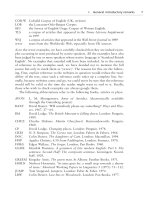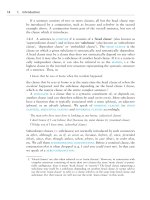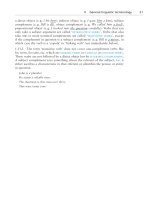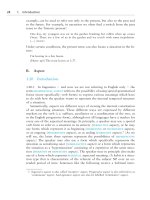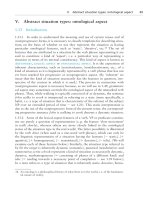The grammar of the english verb phrase part 34 doc
Bạn đang xem bản rút gọn của tài liệu. Xem và tải ngay bản đầy đủ của tài liệu tại đây (600.92 KB, 7 trang )
224 5. The absolute use of the present perfect
Figure 5.3. Representation of the up-to-now reading.
Figure 5.4. Representation of the continuative reading.
interpretations. Whichever interpretation is selected in connection with the
time of the full situation, the semantics of the present perfect is always ‘The
situation time is located in the pre-present zone’, i. e. ‘The pre-present zone
contains the situation time’. As noted in 5.2.3, this leads to two possible T-
interpretations, viz. ‘situation time wholly before t
0
’(ϭ ‘the time of the predi-
cated situation is included in the pre-present’) and ‘situation time up to t
0
’(ϭ
‘the time of the predicated situation is co-extensive with the pre-present’). Each
of the three context-dependent W-interpretations has to fit in with one of these.
5.4.4 The following is a summary of what has been said so far about the
temporal W-interpretations:
(a) The indefinite reading implies that the time of the full situation (and hence
the situation time) is located at some indefinite time in the course of the
pre-present and does not include (or coincide with) the terminal point
of the pre-present, which lies right before t
0
. This is the W-reading that
corresponds with the T-interpretation ‘The situation time is included in
the pre-present’.
The indefinite reading means that the full situation is interpreted as W-bounded
and thus the predicated situation time is the same as the full situation (i. e. the
predicated situation occupies the same interval as the full situation) and is
interpreted as over at t
0
. This is true not only if the present perfect form is
nonstative and nonprogressive, as in He has played football, but also if the
II. The temporal W-interpretations of present perfect clauses 225
present perfect form is stative, as in I’ve been happy, or progressive, as in I’ve
sometimes been watching a film on TV [when Bill suddenly rang at my door]
(where the situation functions as ‘background’ situation for a W-bounding in-
tervening or interrupting situation Ϫ see section (d) of 5.3.2).
(b) The continuative interpretation is an instance of the T-interpretation ‘The
situation time is co-extensive with the pre-present’. The full situation is
W-interpreted as longer than the situation time and hence as still actualiz-
ing at t
0
: Sharon has lived here since she was born implies that Sharon still
lives here. (However, as far as the tense structure is concerned, the situa-
tion time does not include t
0
. The continuative W-interpretation is ren-
dered possible by the fact that the situation time can be shorter than the
time of the full situation, because live here is a homogeneous (atelic) verb
phrase. The continuative interpretation itself is triggered by factors other
than the tense structure, such as the progressive form and/or the presence
of an adverbial like since 1995 or for two weeks now, etc.).
(c) The up-to-now reading is another instance of the T-interpretation ‘The
situation time coincides with the pre-present’. This time the situation time
is interpreted as also being the time of the full situation. The speaker makes
a statement (or asks a question) about the entire (subjectively conceptual-
ized) pre-present zone (which does not include t
0
).
5.4.5 In sum, the three interpretations of present perfect clauses are W-inter-
pretations concerning the location of the time of the full situation relative to
t
0
. They can be distinguished on the basis of the features given in Figure 5.5.
5
For a good understanding of Figure 5.5, the following things should be
noted:
(a) On the up-to-now reading, the time of the full situation is definite by
virtue of being adjacent to t
0
. As we will see in 5.4.7, the situation is often
a ‘hypersituation’ consisting of a number of ‘subsituations’ (e. g. We’ve
been telling our customers that we would give them any information they
might need). In that case the times of the subsituations except the last one
are indefinite, but the time of the hypersituation as a whole is definite.
5. Note that we treat the so-called ‘hot news’, ‘experiential’, and ‘resultative’ interpretations
of some clauses in the present perfect as usage types of the indefinite interpretation Ϫ
see 5.13Ϫ5 and 5.37. Thus, the ‘resultative’ interpretation of a present perfect sentence
like Now she has gone to Singapore is an indefinite reading, in spite of the presence of
the definite time adverb now. The interpretation is indefinite because the location of the
situation time in the pre-present is indefinite, i. e. the time when she went to Singapore
is indefinite. The semantics of the present perfect is all about the temporal location of a
situation time in the pre-present, not about the temporal location of a result, if any.
226 5. The absolute use of the present perfect
Figure 5.5. The features of the W-interpretations of the present perfect.
(b) In a sentence receiving a continuative reading (e. g. We’ve been working since
9), the full situation is not represented as L-bounded and is not usually inter-
preted as W-bounded, as the full situation may easily extend beyond t
0
. How-
ever, the full situation is interpreted as W-bounded if the context makes it
clear that the full situation includes t
0
but does not extend beyond it. This
possibility, though, is more theoretical than real, because it is pragmatically
very unlikely. (Moreover, it is not easy to determine what ‘full situation’
means on a continuative interpretation. In section 5.7 we will make a distinc-
tion between the ‘factual full situation’, which is that part of the situation up
to and including t
0
, and the ‘potential full situation’, which is the full situa-
tion including the potential portion which continues into the post-present.
Needless to say, the former is interpreted as W-bounded Ϫ with t
0
as the pro-
visional endpoint reached Ϫ whereas the latter is not.)
5.4.6 We cannot exaggerate the importance of the statement that the distinc-
tion between ‘continuative perfect’, ‘up-to-now perfect’ and ‘indefinite perfect’
is a matter of temporal W-interpretation rather than of tense-structural ambi-
guity, i. e. that it is not true that the present perfect can express three different
tense structures. There is only one present perfect tense, and its semantics (ϭ
tense structure) is always ‘The situation time is contained in the pre-present’.
It follows that, if for ease of reference we speak of a ‘
continuative perfect’,
we really mean a ‘perfect in a clause receiving a continuative W-interpretation’.
Similarly, the terms ‘
indefinite perfect’ and ‘up-to-now perfect’ are short-
hand for ‘present perfect in a clause receiving an indefinite reading’ and ‘pres-
ent perfect in a clause receiving an up-to-now interpretation’, respectively. And
II. The temporal W-interpretations of present perfect clauses 227
when we speak of ‘continuative / indefinite / up-to-now meaning’, we are
actually using ‘meaning’ in the sense of ‘interpretation’. The readings in ques-
tion are W-interpretations, which can be provoked or excluded by the seman-
tics or pragmatics of the linguistic or extralinguistic context. Let us illustrate
this briefly in connection with the continuative interpretation:
(a) The continuative reading of He has been working in the garden since 8
o’clock is due to the following factors. The use of the progressive form
suggests that the situation time is only some ‘middle part’ of the time of a
larger homogeneous full situation. That middle part is interpreted as coin-
ciding with the period leading up to t
0
specified by the time-specifying
adverbial. Since the time of the full situation is longer than the situation
time, and the latter leads up to t
0
, the full situation is naturally interpreted
as including t
0
(which is the time point adjacent to the terminal point of
the pre-present zone and of the situation time), and often as extending
beyond it.
(b) In examples like I have been taller than my mother since I was twelve the
continuative reading of the head clause is the only one that makes sense.
This is due to pragmatic factors. Firstly, the referent of the subject is the
speaker, who must be alive at t
0
since he is speaking at t
0
. Secondly, as a
rule, once you are taller than your mother you remain taller than her (at
least in the world as we know it). It follows that the speaker must still be
taller than his mother at t
0
. The addressee will therefore assign a continua-
tive interpretation to the head clause of the sentence.
(c) In examples like I’ve sung in the choir for as long as I can remember, the
duration adverbial refers to a period including t
0
and indicates the duration
of the ‘factual full situation’ (i. e. the full situation as it has actualized over
a period reaching up to and including t
0
Ϫ see 5.7).
6
In doing so the
duration adverbial triggers a continuative interpretation. (The precondi-
tion for the continuative reading Ϫ that the situation be homogeneous, in
other words that the situation time can be a proper subpart of the time of
the full situation Ϫ is satisfied because I’ve sung in the choir refers to a
permanent habit: as noted in 1.23.3, a habit is a kind of state; a state that
is not represented as restricted in time by an adverbial like until five or for
two hours is by definition L-nonbounded and therefore homogeneous.)
6. Since this reading means that the full situation includes the entire pre-present zone plus
t
0
, the duration adverbial indirectly also specifies the length of the pre-present zone
(which has the same duration except that it does not include t
0
). In 2.22.3 we have
named such adverbials which specify not only duration but also time ‘bifunctional tem-
poral adverbials’.
It may also be noted that in the discussion here we are only concerned with the
continuative reading of I’ve sung in the choir for as long as I can remember. The up-to-
now reading is disregarded.
228 5. The absolute use of the present perfect
(d) The same is true of examples like She’s known him for many years now.
The adverbial for many years now indicates a period which includes t
0
.
Like any duration adverbial, it specifies the time of the full situation, which
therefore also includes t
0
. The result is a continuative interpretation.
Apart from cases like the above ones, in which a continuative reading is invited
by an adverbial and/or the progressive form and/or pragmatic factors, a continu-
ative interpretation will not suggest itself, because the semantic structure of
the present perfect does not itself invite such a reading. The idea ‘The pre-
present contains the situation time’ does not by itself suggest that the situation
time is only part of the full situation (which is a precondition for a continuative
interpretation). In fact, there is nothing in the semantics of the present perfect
that provides information about whether the time of the full situation extends
into a time-zone, or time-zones, other than the pre-present zone in which the
situation time is located. This is clear from a comparison of the following
examples: the examples in (1) all invite a continuative reading, whereas the
examples in (2), which are the same as the examples in (1) except that they are
stripped of the progressive form and/or the time-specifying adverbial, all re-
ceive an indefinite interpretation:
(1) I have been working in the garden since 8 o’clock. (single continuative dynamic
situation)
Mr Whorf has been our sales representative for 21 years. (continuative state)
He’s been going to that shop for as long as I can remember. (continuative habit:
‘He’s had the habit of going to that shop for as long as I can remember’)
Bridget has sung in the church choir for 15 years. (continuative habit)
(2) I have worked in the garden. (indefinite reading)
Mr Whorf has been our sales representative. (indefinite reading)
He’s gone to that shop. (indefinite reading)
Bridget has sung in the church choir. (indefinite reading)
The only clue as to the temporal interpretation of the sentences in (2) is the
semantics of the present perfect: the situation time is contained in the pre-
present. Since the pre-present leads up to t
0
but does not include t
0
, and since
there is no indication that the situation time is only part of the time of the full
situation, these sentences naturally receive a noncontinuative interpretation
(i. e. the situation time does not include t
0
and is the time of the full situation).
That the noncontinuative interpretation in question is an indefinite one rather
than an up-to-now reading follows from the fact that a nonprogressive form
is used Ϫ see 5.25Ϫ29.
5.4.7 As we will see in 5.17Ϫ19, there are various kinds of up-to-now read-
ing. We are going to introduce them in a nutshell here because we need the
terms for a good understanding of the subsections of 5.5. The various kinds of
up-to-now reading all have in common that the full situation is taken to cover
II. The temporal W-interpretations of present perfect clauses 229
the entire pre-present, i. e. the full situation leads up to t
0
in such a way that
it does not include t
0
and that there is no significant interval between the end
of the full situation and t
0
.
One type of up-to-now reading is the ‘
constitution reading’. Here the
speaker looks back on the pre-present to ‘measure it’ or to see how this period
has been filled ‘situationwise’. The speaker thus focuses on the situational con-
stitution of the pre-present zone and not only on the temporal location of a
situation in that zone. On the constitution reading the pre-present may be filled
either by one full situation which actualizes throughout the pre-present period
(but without including t
0
) or by a number of full situations which (possibly in
combination with gaps) form a ‘hypersituation’ which coincides with the pre-
present but does not include t
0
. In the latter case, the number of constituting
subsituations may be zero, one or more.)
There are three subtypes of constitution reading, all of which are ‘specifica-
tional’ (see 5.20):
(a) The speaker may be concerned with the nature of the situation that is
conceived of as having lasted throughout the pre-present without including
t
0
(e. g. What have you been doing?; Where have you been?). In that case
there is a ‘
nonquantificational constitution’ interpretation.
(b) The speaker may be concerned with the length of the pre-present zone and
indicate this by a bounded present perfect sentence referring to a duration-
specifying situation (e. g. Nearly a year has gone by since then). In that
case there is a ‘
duration-quantifying constitution’ interpretation.
(c) The speaker may also be concerned with how many times a specific situa-
tion (or kind of situation) has actualized in the course of the pre-present
(e. g. How many times have you met him in the past week?). In that case
there is a ‘
number-quantifying constitution’ interpretation.
An up-to-now reading which is not a constitution reading, because it is not
‘specificational’ (see 5.20), will be called an ‘
unmarked up-to-now’ reading.
An example is You’ve been thinking of something else all the time I’ve been
talking to you about this machine.
The label ‘quantificational constitution reading’ will be used as a
cover-term for duration-quantifying constitution readings and number-quanti-
fying constitution readings.
5.5 Further arguments for distinguishing between three
W-interpretations
5.5.1 The need for distinguishing between three different W-interpretations
of present perfect clauses is particularly clear from the fact that one and the
230 5. The absolute use of the present perfect
same present perfect form is sometimes compatible with each of the three inter-
pretations. This is true of have been, which can be used in three kinds of (W-
interpretation-determining) context. Compare the following:
[How much longer will I have to wait?] I have been here since five a.m. (continua-
tive reading)
[Oh, there you are!] Where have you been all this time? (up-to-now reading)
Have you ever been in Singapore at New Year? (indefinite reading of the subtype
‘perfect of experience’ Ϫ see 5.13.1)
The American president has been in Beijing today. (Nothing in the sentence repre-
sents the situation as bounded. Out of context, both a continuative and an indefinite
interpretation are possible.)
The American president has been in Beijing today. [Now he is on his way to Shang-
hai.] (The second sentence rules out the continuative interpretation of the first.)
The American president has been in Beijing all day today. [Now he is on his way to
Shanghai.] (The second sentence again rules out the continuative interpretation of
the first. The presence of all day enforces the up-to-now reading.)
Similarly, the present perfect form have been waiting can be used in three kinds
of (disambiguating) context:
I’ve been waiting for her for nearly half an hour now. (continuative reading)
[Oh, there she is!] I’ve been waiting for her. (up-to-now reading)
[This isn’t the first time I’ve waited for her. In fact, she’s often gone on business trips
and] every time I’ve been waiting for her when she’s arrived back. (indefinite reading)
5.5.2 The threefold interpretive distinction has a few grammatical correlates.
Firstly, some temporal adverbials are compatible with one or two of the read-
ings only. For example:
From childhood she’s had a timid character. (continuative reading only)
I’ve hated her ever since (I was a child). (continuative reading only)
Has she ever been in a foul temper? (indefinite interpretation only)
[I’ve been away for two hours, and] all this time you’ve been sitting there doing
nothing! (indefinite and continuative readings excluded)
Where have you been {within / in} the last four days? (continuative reading ex-
cluded)
Where have you been for the last four days? (indefinite and continuative readings ex-
cluded)
I’ve killed three people in the past. (indefinite interpretation only; this can only mean
that there has been an occasion in the past on which I killed three people: the


